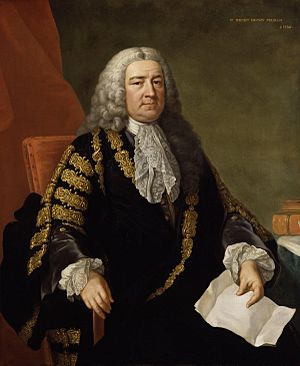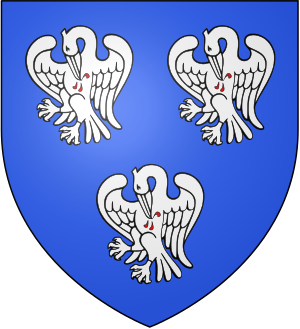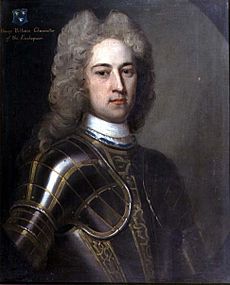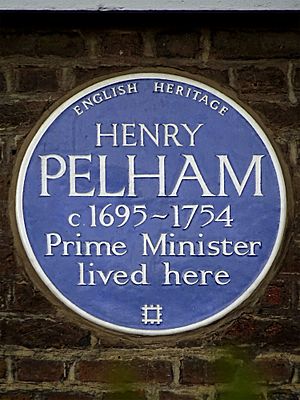Henry Pelham facts for kids
Quick facts for kids
Henry Pelham
|
|
|---|---|

Pelham by John Shackleton, c. 1752
|
|
| Prime Minister of Great Britain | |
| In office 27 August 1743 – 6 March 1754 |
|
| Monarch | George II |
| Preceded by | The Earl of Wilmington |
| Succeeded by | The Duke of Newcastle |
| Chancellor of the Exchequer | |
| In office 12 December 1743 – 6 March 1754 |
|
| Monarch | George II |
| Preceded by | Samuel Sandys |
| Succeeded by | William Lee |
| Personal details | |
| Born | 25 September 1694 Laughton, Sussex, England |
| Died | 6 March 1754 (aged 59) Westminster, England |
| Resting place | All Saints' Church, Laughton, East Sussex, England |
| Political party | Whig |
| Spouse | |
| Children | 4 |
| Parent |
|
| Alma mater | |
Henry Pelham (born September 25, 1694 – died March 6, 1754) was an important British politician. He was a member of the Whig party. He served as the Prime Minister of Great Britain from 1743 until he died in 1754.
Henry Pelham was the younger brother of Thomas Pelham-Holles, 1st Duke of Newcastle. His brother also worked in Pelham's government and later became Prime Minister himself. Many people consider Henry Pelham to be Britain's third Prime Minister. The first two were Robert Walpole and the Earl of Wilmington.
During Pelham's time as Prime Minister, Great Britain was mostly peaceful at home. However, the country did experience the Jacobite uprising of 1745. In foreign affairs, Britain was involved in several wars. After Pelham's death, his brother, the Duke of Newcastle, took over the government.
Early Life and Education
Henry Pelham was the younger son of Thomas Pelham, 1st Baron Pelham. His mother was Grace Pelham. He went to Westminster School for his early education.
Later, he studied at King's College, Cambridge starting in 1709. He then moved to Hart Hall, Oxford in 1710.
In 1715, Henry Pelham served as a volunteer in a regiment during the Battle of Preston. After this, he spent some time traveling in Europe. His brother, the Duke of Newcastle, helped him become a Member of Parliament for Seaford in 1717. He represented Seaford until 1722.
Political Career
Henry Pelham's family had a lot of influence in politics. With the help of Robert Walpole, he became a Lord of the Treasury in 1721. This was an important role in managing the country's money.
In the 1722 election, he was elected as a Member of Parliament for Sussex county. In 1724, he joined the government as Secretary at War. This job involved managing the army. In 1730, he took on the role of Paymaster of the Forces, which was a more profitable position.
Pelham strongly supported Robert Walpole's policies, including the one about excise taxes. He, his brother Newcastle, and Prime Minister Walpole often met at Houghton Hall. They would plan many of the country's policies there. These meetings were known as the Norfolk Congress.
Henry Pelham also helped start the Foundling Hospital in 1739. This was a popular charity that cared for abandoned children. Like his brother, Pelham was also an active Freemason.
In 1742, different political groups came together to form a new government. The next year, in 1743, Henry Pelham became Prime Minister. He took over after the death of the Earl of Wilmington.
Prime Minister

When Pelham first became Prime Minister, his government was seen as a continuation of the previous one. Lord Carteret remained in charge of foreign affairs. Carteret was very close to King George II.
Pelham held several important roles. He was the First Lord of the Treasury, which meant he was in charge of the country's finances. He was also the Chancellor of the Exchequer, another key financial role. And he was the Leader of the House of Commons, guiding laws through Parliament.
In 1744, the Pelham brothers (Henry and Newcastle) wanted Lord Carteret out of the government. Henry Pelham told the King that if Carteret didn't leave, the Pelhams and their supporters would resign. This would leave the King without a government. Carteret had to step down.
After this, Henry Pelham shared power with his brother, the Duke of Newcastle. Henry was seen as the main leader, but his brother had a lot of power and influence in the government. Even though they were close, they sometimes had disagreements.
"The Broad-Bottomed Administration"
Pelham wanted peace and tried to end the War of the Austrian Succession. The country was tired of the long war and generally agreed with his foreign policy.
In 1746, King George II tried to replace Pelham's government. However, Henry and Newcastle resigned, and the new leaders couldn't form a government. So, the King asked the Pelhams to return. One of their conditions was that the King should fully trust his government.

During this time, the power of the Prime Minister grew. It became clear that the Prime Minister's power depended on having the support of most members of the House of Commons. It was less about the King's personal choices.
King George II had a difficult relationship with his son, Frederick, Prince of Wales. In 1748, Frederick planned to try and remove the Pelhams from power in the next election. To prevent this, Henry Pelham asked the King to hold an early election in 1747. Over time, Henry Pelham and the King developed a closer relationship. When Pelham died in 1754, the King famously said, "Now I shall have no more peace."
The Treaty of Aix-la-Chapelle was signed in 1748, ending the war. This allowed Pelham to make cuts to government spending.
He reduced spending on the Army and Navy. Pelham also worked to lower interest rates on the national debt from 4% to 3% by 1757. He helped create a fund to reduce the country's debt. In 1749, the Consolidation Act was passed, which reorganized the Royal Navy.
Pelham also made changes to the calendar. On March 20, 1751, New Year's Day officially became January 1st. Britain then adopted the Gregorian calendar a year later. In 1752, he managed to reduce the land tax from 20% to 10%.
During this period, there were social problems related to alcohol. To address this, the government introduced the Gin Act 1751. This law aimed to control the sale of liquor. It reduced the number of places that could sell alcohol. By limiting the supply, consumption decreased, and the problem became more manageable.
Two of Pelham's last important laws were the Jew Bill of 1753 and the Marriage Act of 1753. The Jew Bill allowed Jewish people to become British citizens more easily. The Marriage Act set a minimum age for marriage. After Pelham's death, his brother, the Duke of Newcastle, became the new head of the government.
Achievements
Henry Pelham was good at keeping different groups in his government working together. He had good tact and understood how the House of Commons worked. Even if there were disagreements within his government, they never became public problems.
His foreign policy focused on peace, similar to Robert Walpole's approach. His financial policies were very successful after the war ended in 1748. He reduced the size of the armed forces and cut government spending. He also lowered the interest on the national debt. In 1752, he reduced the land tax.
Historians Stephen Brumwell and W.A. Speck describe him as a smart and careful politician. They note that he was honest, which was rare for politicians at the time. Unlike Walpole, he did not become very rich from his time in office.
Personal Life
Henry Pelham married Lady Catherine Manners on October 31, 1726. She was the daughter of the 2nd Duke of Rutland. They had four daughters:
- Catherine Pelham-Clinton (1727–1760), who married Henry Clinton.
- Frances (1728–1775), who never married.
- Grace Watson (1735–1777), who married the Hon. Lewis Watson.
- Mary (1739–????), who also never married.
When Pelham became Prime Minister, he started building a house at 22 Arlington Street in London. He hired the architect William Kent to design it. The house was finished in 1754.
Henry Pelham was buried in All Saints' Church in Laughton, East Sussex. He was the first British Prime Minister who was never given a noble title during his lifetime.
His personal papers are now kept at The University of Nottingham.
Arms
 |
|
Images for kids
See also
 In Spanish: Henry Pelham para niños
In Spanish: Henry Pelham para niños








